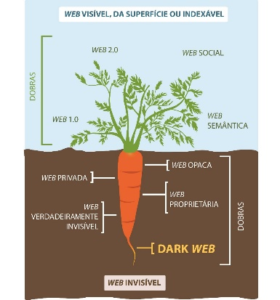Richele Grenge Vignoli, PhD student at the Postgraduate Program in Information Science at Unesp, Campus Marília, SP, Brazil.
The purpose of the research was to demonstrate the main differences and common points of Deep Web and Dark Web. The article “Deep Web and Dark Web: similarities and disparities in the context of Information Science”, published in the journal TransInformation (vol. 32), was carried out by PhD student Richele Grenge Vignoli and Associatet Professor Silvana Drumond Monteiro. The theme has been researched for some years by researchers who mainly use the bibliographic and documentary method in the analysis of the sources and texts that discuss the subject. In this study, carried out in 2019 and completed in 2020, the databases consulted for this research were the Web of Science, Scopus Elsevier, Scientific Electronic Library Online, Referential Database of Journal Articles in Information Science, Science Direct, Google Scholar and several scientific journals.
The Deep Web, a term whose translation is “Rede Profunda” in the Portuguese language, was coined in 1994 by Jill Ellsworth and represents an exponent layer of the internet that, in most cases, contains non-recoverable or indexable content by search engines like Google. The Dark Web, or “Rede Escura”, started with the doctoral thesis entitled Ian Clarke’s Distributed Decentralized Information Storage and Retrieval System, at Edinburgh University in 1995 by means of the Freenet software. The Dark Web is like an even deeper layer of the Deep Web and that is only possible through a proxy, which disguises the Internet Protocol (IP). The purpose of the study was to define and demonstrate the main differences between the webs so that conceptual confusions, always recurring to the theme, could be resolved. In addition to designing new research on the subject, the research aims to demonstrate that thousands of people use the Deep Web daily and / or do not use it due to lack of knowledge. As for the Dark Web, it was emphasized that it is possible to use it daily without having to access illicit or illegal information. Freedom of surfing the internet and the possibility of maintaining privacy online are its main attractions. In order to do that, it is important to know the environments, as well as the paths that lead to the access of the referred webs. Both Deep and Dark Web are rich in varied and useful content and information, one only has to know how to access and use them.
The researchers have been dedicated to the study of the dark and hidden layers of cyberspace since 2013. In their academic work and in view of the many accesses to Deep and Dark Web as a method of observation and obtaining information, the motivation for research has always been based on the dissemination and instruction about environments and their academic potential before society. In other studies from 2013, 2014 and 2015, the authors and other partners sought to conceptualize and “reveal” dark, hidden, underground and other cyberspace webs, as well as to disseminate them to the academic community, mainly as a way to enhance their researched character and undo prejudices and misinformation about the webs.
Some results of disparities between Deep and the Dark Web are: the term Deep Web is confused and occasionally defined as a synonym for Dark Web and other Webs and vice versa; the Deep Web has an astronomical dimension, which can present 96% of all cyberspace, however the Dark Web would total only 6%; metaphorically, in cyberspace, the Deep Web is represented just below the surface, and the Dark Web would be the deepest layer of cyberspace; Deep Web content can be indexed, but Dark Web content will probably never be, in addition to others presented in this study. Therefore, demystifying and demonstrating the main differences and similarities of Deep and Dark Web, as well as presenting their location and definition, conjecture themselves as a useful field for new research on the theme essentially in Information Science, a science that is concerned with manifestations different from its main object, the information. In this regard, these webs are perpetuated by thousands of terabytes of more content than the surface web, which we use daily, such as through Google and social networks.
Therefore, both scholars and society in general need to know the Deep and the Dark Web, either to have access to a world of information by means of the main search engines, either to surf the internet quietly and with no invasion of privacy. The challenges in demystifying and dislodging prejudices related to the webs, as well as the understanding that they are similar, but different. Therefore, new research on the subject need to be carried out so that the community knows and can benefit from the opportunities and relevant information found in the environments.
References
MONTEIRO, S. D. and FIDÊNCIO, M. V. As dobras semióticas do ciberespaço: da web visível à invisível. Transinformação [online]. 2013, vol. 25, no. 1, pp. 35-46. ISSN: 0103-3786 [viewed 21 August 2020]. DOI: 10.1590/S0103-37862013000100004. Available from: http://ref.scielo.org/82kcdv
VIGNOLI, R. G. A topografia da dark web e seus não lugares: por um estudo das dobras invisíveis do ciberespaço. 2014. 153 f. Dissertação (Mestrado em Ciência da Informação) – Universidade Estadual de Londrina, Londrina, 2014. Available from: http://www.bibliotecadigital.uel.br/document/?view=vtls 000191992
VIGNOLI, R. G. and MONTEIRO, S. D. A Dark Web e seu conteúdo informacional. In: SEMINÁRIO DE CIÊNCIA DA INFORMAÇÃO, 5., 2015a, Londrina. Anais eletrônicos […] [viewed 21 August 2020]. Available from: http://www.uel.br/eventos/cinf/index.php/secin2016/secin2016/paper/viewFile/266/186
VIGNOLI, R. G. and MONTEIRO, S. D. Dark Web e seus não lugares: por um estudo das dobras invisíveis do ciberespaço. Liinc em Revista [online], 2015b, vol. 11, no. 1, pp. 140-166. ISSN: 1808-3536 [viewed 21 August 2020]. DOI: 10.18617/liinc.v11i1.798. Available from: http://revista.ibict.br/liinc/article/view/3635/3099
To read the article, access
VIGNOLI, R. G. and MONTEIRO, S. D. Deep Web e Dark Web: similaridades e dissiparidades no contexto da Ciência da Informação. Transinformação [online]. 2020, vol. 32, e190052. ISSN: 2318-0889 [viewed 21 August 2020]. DOI: 10.1590/2318-0889202032e190052. Available from: http://ref.scielo.org/kg92ht
External link
Transinformação – TINF: www.scielo.br/tinf
Como citar este post [ISO 690/2010]:















Recent Comments